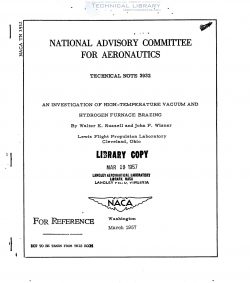naca-tn-3932
- Version
- 68 Downloads
- 1.17 MB File Size
- 1 File Count
- January 31, 2017 Create Date
- January 31, 2017 Last Updated
National Advisory Committee for Aeronautics, Technical Notes - An Investigation of High Temperature Vacuum and Hydrogen Furnace Brazing

The vacuum and the hydrogen brazing of four heat-resistant alloys
with two types of high-temperature brazing alloy were investigated. The
effect of time at two brazing temperatures on the 12000 F shear strength
of Joints and on the base-metal properties was studied.
Brazing techniques were evaluated for alloys that can be age hard-
ened and that contain titanium and aluminum in a vacuum as well as in
dry hydrogen.
In general, results showed that of the two brazing alloys used, the
boron-free alloy was less damaging to base metal than the boron-bearing
alloy, but that shear joints made with the boron—bearing braze were
stronger. Although it was thought that the primary difference between
the alloys was boron content, the higher carbon of the boron-bearing al-
loy may be significant.
Furnace brazing temperatures and time at temperatures were important
factors in lowering the tensile strength and elongation of braze-coated
sheet—metal tensile specimens. The effects varied depending on the base
metal and the brazing alloy used.
Shear specimens of all four base alloys brazed in hydrogen with both
types of brazing alloy exhibited erratic joint coverage by the brazing
alloys. The data indicated, however, that if joint coverage was complete,
vacuum and hydrogen brazing produced joint shear strengths of about the
same magnitude.
During the last five years, interest in high-temperature brazing of
heat-resistant alloys has been growing steadily. Advancements in dry-
hydrogen furnace—brazing techniques have attracted the attention of en-
gineers and designers in many fields of engineering. With furnace braz-
ing it is possible to fabricate intricate parts and assemblies that would
be otherwise impossible. The use of light-weight sheet—metal components
for turboJet engines, now being evaluated by research groups throughout
the country, depends largely on successful furnace brazing.
| File | Action |
|---|---|
| naca-tn-3932 An Investigation of High Temperature Vacuum and Hydrogen Furnace Brazing.pdf | Download |

Comment On This Post